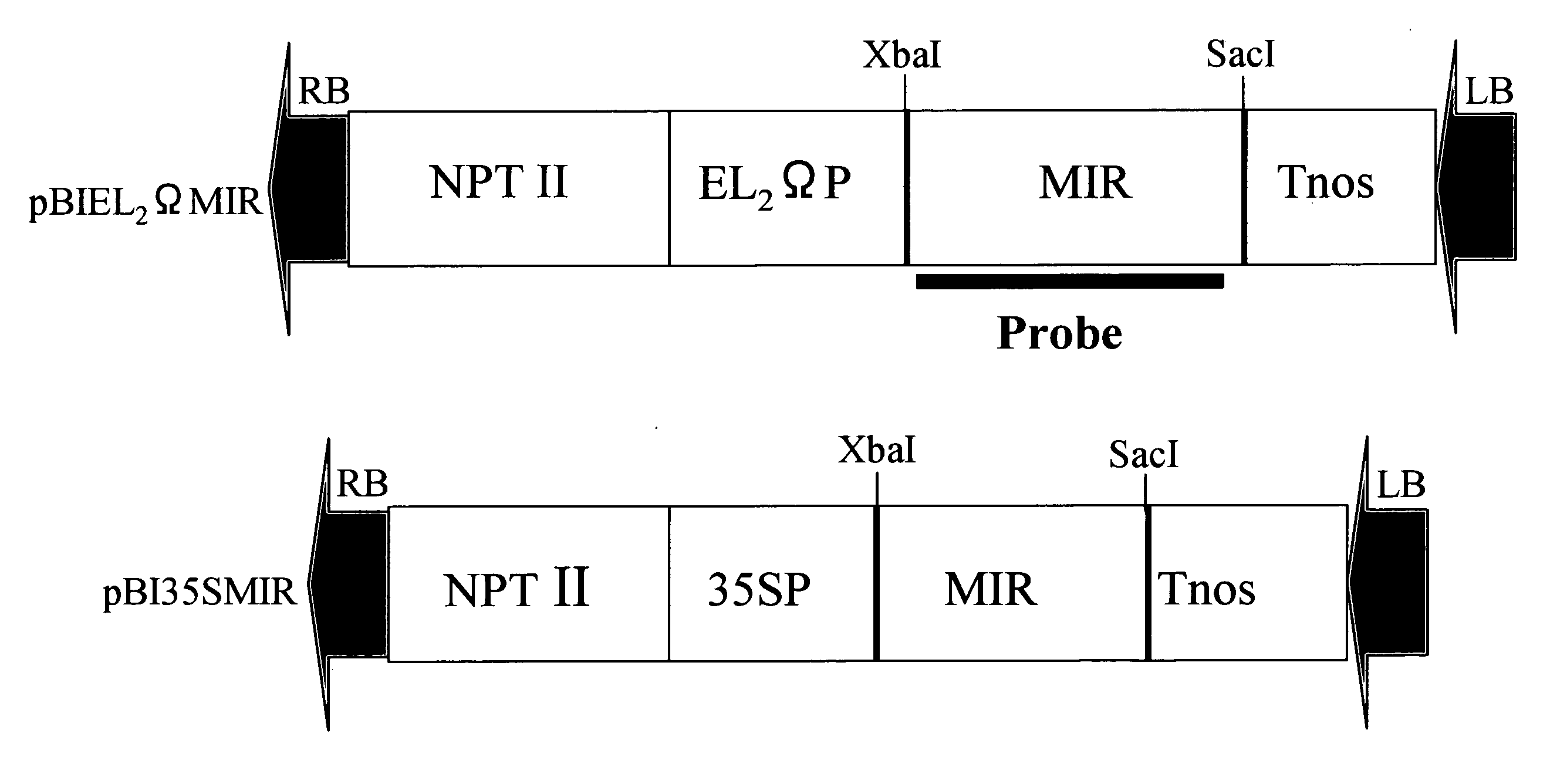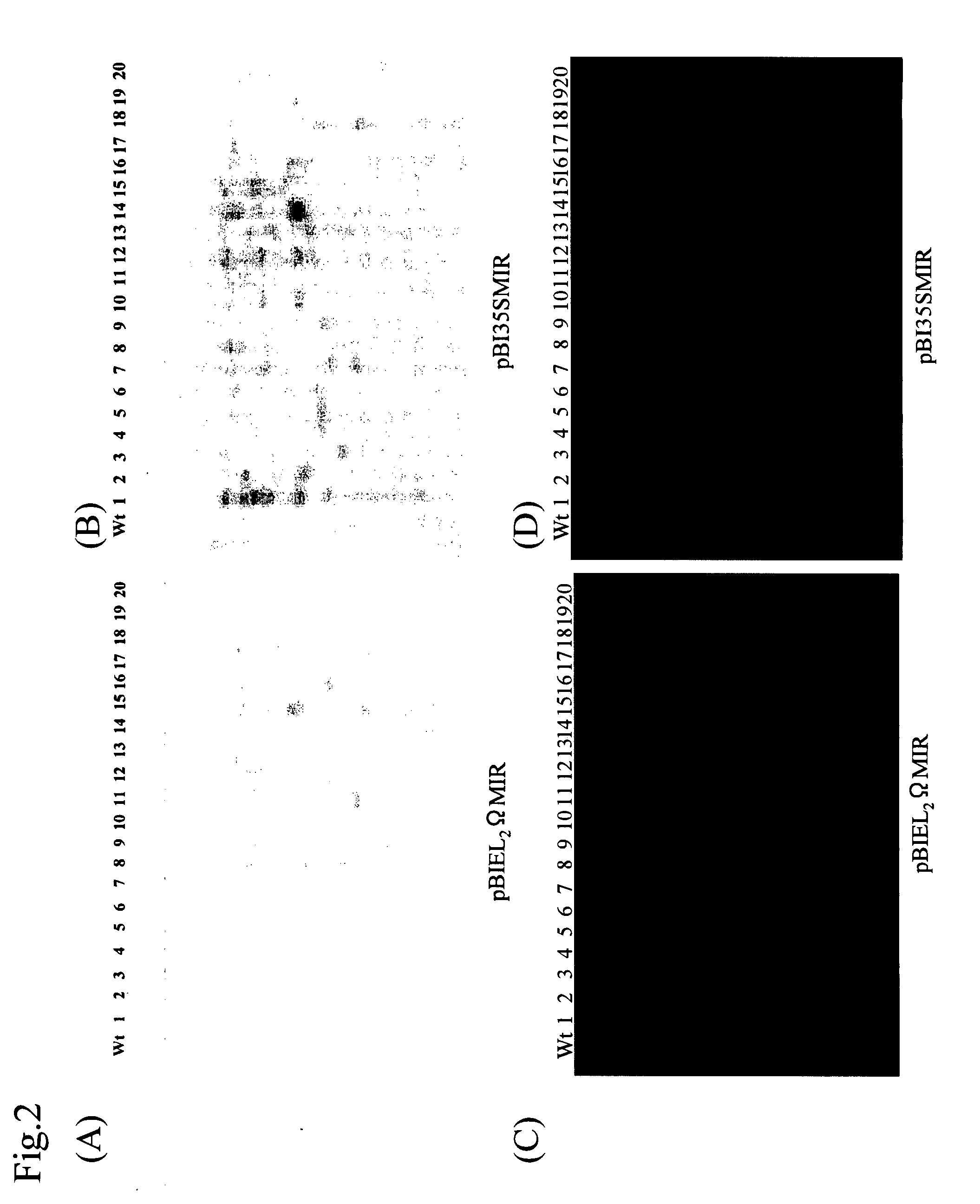Method for Producing Genetically Modified Plant Expressing Miraculin
a technology of miraculin and genetically modified plants, which is applied in the direction of peptide/protein ingredients, peptide sources, metabolic disorders, etc., can solve the problems of miraculin, the functional ingredient of miraculin, and the insufficient supply of miracle fruits, so as to suppress excessive sugar intake, reduce stress, and maintain the calories in the food at a low level
- Summary
- Abstract
- Description
- Claims
- Application Information
AI Technical Summary
Benefits of technology
Problems solved by technology
Method used
Image
Examples
example 1
Cloning and Sequencing Analysis of Miraculin Gene
[0091]In this experiment, a miracle fruit and the leaves thereof were used as source materials for cloning a miraculin gene. The gene was obtained by the following method. Total RNA was extracted from the miracle fruit and the leaves thereof using a phenol-SDS method and then cDNA was synthesized from them with a RT-PCR high kit (Toyobo). Miraculin cDNA was amplified by PCR using the thus obtained cDNA as a template and two specific primers that had been designed based on the cDNA sequence information of the miraculin gene (Matuda et al., 1995): a sense primer 5′-TTTTCTAGAATGAAGGAATTAACAATGCT-3′ (SEQ ID NO: 3) in which a restriction enzyme Xba I site had been added and an antisense primer 5′-TTTGAGCTCTTAGAAGTATACGGTTTTGT-3′ (SEQ ID NO: 4) in which restriction enzyme Sac I site had been added. The PCR was performed with heat denaturation at 95° C. for 5 minutes, followed by 40 cycles of 95° C. for 1 minute, 57° C. for 1 minute, and 72°...
example 2
Construction of Plant Expression Vectors and Introduction of the Same into Agrobacterium
[0092]Plasmids were extracted from Escherichia coli (JM109) harboring the plasmid pUCMRL19, according to a standard method. The miraculin gene portion was excised using restriction enzymes Xba I and Sac I from the resulting plasmids. The portion was then cloned into GUS gene sites of a binary vector pBI121 for plant expression and a modified vector (high-expression vector) which had been made by modifying CaMV35S promoter region in pBI121. These resulting plasmids were designated pBI35SMIR and pBIEL2ΩMIR, respectively (FIG. 1). Escherichia coli JM109 harboring each of the plasmids were cultured and maintained in LB media with 100 mg / L antibiotic kanamycin. Subsequently, Agrobacterium strain GV2260 was transformed with each of these 2 plasmids by electroporation. The thus transformed Agrobacterium strain GV2260 (into,which pBI35SMIR or pBIEL2ΩMIR had been introduced) were cultured and maintained ...
example 3
Preparation of Lettuce Recombinants
[0093]The miraculin gene was introduced into lettuce plants (cultivar ‘Kayser’; diploid) by a leaf disc method using the Agrobacterium strain GV2260 harboring pBI35SMIR or pBIEL2ΩMIR. The transformed Agrobacterium cells were shake-cultured overnight in LB media with 100 mg / L kanamycin. After washing by centrifugation, the cells were suspended in an MS liquid medium with 200 μM acetosyringone and 10 μM mercaptoethanol at an OD600 of 0.1. Sterile lettuce leaf sections at day 5 after seeding were immersed in the thus obtained Agrobacterium solutions. The lettuce leaf sections subjected to the infection with the Agrobacterium were co-cultured for 3 days in MS media with 1 mg / L benzyladenine (BA) and 0.1 mg / L naphthalenacetic acid (NAA). Subsequently, the sections were transferred to selection MS media with 0.1 mg / L BA, 0.1 mg / L NAA, and 100 mg / L kanamycin and then cultured while changing the media every 2 weeks. Shoots that had differentiated therein w...
PUM
| Property | Measurement | Unit |
|---|---|---|
| temperature | aaaaa | aaaaa |
| temperature | aaaaa | aaaaa |
| temperature | aaaaa | aaaaa |
Abstract
Description
Claims
Application Information
 Login to View More
Login to View More - R&D
- Intellectual Property
- Life Sciences
- Materials
- Tech Scout
- Unparalleled Data Quality
- Higher Quality Content
- 60% Fewer Hallucinations
Browse by: Latest US Patents, China's latest patents, Technical Efficacy Thesaurus, Application Domain, Technology Topic, Popular Technical Reports.
© 2025 PatSnap. All rights reserved.Legal|Privacy policy|Modern Slavery Act Transparency Statement|Sitemap|About US| Contact US: help@patsnap.com



